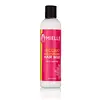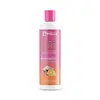What's inside
What's inside
 Key Ingredients
Key Ingredients

 Benefits
Benefits

 Concerns
Concerns

 Ingredients Side-by-side
Ingredients Side-by-side

Water
Skin ConditioningAloe Barbadensis Leaf Juice
Skin ConditioningGlycerin
HumectantPersea Gratissima Oil
Skin ConditioningBehentrimonium Methosulfate
Cetyl Alcohol
EmollientCaprylic/Capric Triglyceride
MaskingCetyl Esters
EmollientCetearyl Alcohol
EmollientPhenoxyethanol
PreservativeButyrospermum Parkii Butter
Skin ConditioningPolyquaternium-7
Parfum
MaskingHydroxypropyltrimonium Honey
Panthenol
Skin ConditioningOryza Sativa Bran Oil
EmollientSimmondsia Chinensis Seed Oil
EmollientHydrolyzed Wheat Protein
Skin ConditioningAchillea Millefolium Extract
CleansingUrtica Dioica Leaf Extract
Skin ConditioningSalvia Officinalis Extract
AntimicrobialEquisetum Arvense Extract
AstringentLavandula Angustifolia Flower/Leaf/Stem Extract
MaskingBenzoic Acid
MaskingEthylhexylglycerin
Skin ConditioningGlycereth-2 Cocoate
EmulsifyingWater, Aloe Barbadensis Leaf Juice, Glycerin, Persea Gratissima Oil, Behentrimonium Methosulfate, Cetyl Alcohol, Caprylic/Capric Triglyceride, Cetyl Esters, Cetearyl Alcohol, Phenoxyethanol, Butyrospermum Parkii Butter, Polyquaternium-7, Parfum, Hydroxypropyltrimonium Honey, Panthenol, Oryza Sativa Bran Oil, Simmondsia Chinensis Seed Oil, Hydrolyzed Wheat Protein, Achillea Millefolium Extract, Urtica Dioica Leaf Extract, Salvia Officinalis Extract, Equisetum Arvense Extract, Lavandula Angustifolia Flower/Leaf/Stem Extract, Benzoic Acid, Ethylhexylglycerin, Glycereth-2 Cocoate
Water
Skin ConditioningCocos Nucifera Oil
MaskingSorbitol
HumectantIsopropyl Myristate
EmollientCetearyl Alcohol
EmollientSodium Stearyl Sulfate
CleansingCyclopentasiloxane
EmollientGlyceryl Stearate Se
EmulsifyingOlea Europaea Fruit Oil
MaskingStearic Acid
CleansingCarthamus Tinctorius Seed Oil
MaskingRicinus Communis Seed Oil
MaskingOryza Sativa Bran Water
MaskingBrassica Campestris Seed Oil
Skin ConditioningCitrus Junos Peel Extract
Skin ConditioningPolyglyceryl-3 Diisostearate
EmulsifyingPhenoxyethanol
PreservativeBenzoic Acid
MaskingEthylhexylglycerin
Skin ConditioningGlycereth-2 Cocoate
EmulsifyingDiheptyl Succinate
EmollientCapryloyl Glycerin/Sebacic Acid Copolymer
Skin ConditioningXanthan Gum
EmulsifyingAminomethyl Propanol
BufferingBHT
AntioxidantDisodium EDTA
Hydrolyzed Milk Protein
Skin ConditioningParfum
MaskingWater, Cocos Nucifera Oil, Sorbitol, Isopropyl Myristate, Cetearyl Alcohol, Sodium Stearyl Sulfate, Cyclopentasiloxane, Glyceryl Stearate Se, Olea Europaea Fruit Oil, Stearic Acid, Carthamus Tinctorius Seed Oil, Ricinus Communis Seed Oil, Oryza Sativa Bran Water, Brassica Campestris Seed Oil, Citrus Junos Peel Extract, Polyglyceryl-3 Diisostearate, Phenoxyethanol, Benzoic Acid, Ethylhexylglycerin, Glycereth-2 Cocoate, Diheptyl Succinate, Capryloyl Glycerin/Sebacic Acid Copolymer, Xanthan Gum, Aminomethyl Propanol, BHT, Disodium EDTA, Hydrolyzed Milk Protein, Parfum
Ingredients Explained
These ingredients are found in both products.
Ingredients higher up in an ingredient list are typically present in a larger amount.
Benzoic Acid is used to preserve and adjust the pH of products.
The antimicrobial property of Benzoic Acid helps elongate a product's shelf life. Its main role is to reduce fungi growth and is not found to be effective at fighting bacteria. Therefore Benzoic Acid is always added along with other preservatives.
In its pure form, Benzoic Acid looks like a white crystalline solid. It has slight solubility in water.
The name of Benzoic Acid comes from gum benzoin, which used to be the sole source of deriving this ingredient. Benzoic Acid is the most simple aromatic carboxylic acid.
Benzoic Acid is naturally occuring in strawberries, mustard, cinnamon, and cloves. It has a slight scent but is not considered to be a fragrance.
Learn more about Benzoic AcidCetearyl alcohol is a mixture of two fatty alcohols: cetyl alcohol and stearyl alcohol. It is mainly used as an emulsifier. Emulsifiers help prevent the separation of oils and products. Due to its composition, it can also be used to thicken a product or help create foam.
Cetearyl alcohol is an emollient. Emollients help soothe and hydrate the skin by trapping moisture.
Studies show Cetearyl alcohol is non-toxic and non-irritating. The FDA allows products labeled "alcohol-free" to have fatty alcohols.
This ingredient is usually derived from plant oils such as palm, vegetable, or coconut oils. There is debate on whether this ingredient will cause acne.
Due to the fatty acid base, this ingredient may not be Malassezia folliculitis safe.
Learn more about Cetearyl AlcoholEthylhexylglycerin (we can't pronounce this either) is commonly used as a preservative and skin softener. It is derived from glyceryl.
You might see Ethylhexylglycerin often paired with other preservatives such as phenoxyethanol. Ethylhexylglycerin has been found to increase the effectiveness of these other preservatives.
Glycereth-2 Cocoate can be bad for dry skin.
Parfum is a catch-all term for an ingredient or more that is used to give a scent to products.
Also called "fragrance", this ingredient can be a blend of hundreds of chemicals or plant oils. This means every product with "fragrance" or "parfum" in the ingredients list is a different mixture.
For instance, Habanolide is a proprietary trade name for a specific aroma chemical. When used as a fragrance ingredient in cosmetics, most aroma chemicals fall under the broad labeling category of “FRAGRANCE” or “PARFUM” according to EU and US regulations.
The term 'parfum' or 'fragrance' is not regulated in many countries. In many cases, it is up to the brand to define this term.
For instance, many brands choose to label themselves as "fragrance-free" because they are not using synthetic fragrances. However, their products may still contain ingredients such as essential oils that are considered a fragrance by INCI standards.
One example is Calendula flower extract. Calendula is an essential oil that still imparts a scent or 'fragrance'.
Depending on the blend, the ingredients in the mixture can cause allergies and sensitivities on the skin. Some ingredients that are known EU allergens include linalool and citronellol.
Parfum can also be used to mask or cover an unpleasant scent.
The bottom line is: not all fragrances/parfum/ingredients are created equally. If you are worried about fragrances, we recommend taking a closer look at an ingredient. And of course, we always recommend speaking with a professional.
Learn more about ParfumPhenoxyethanol is a preservative that has germicide, antimicrobial, and aromatic properties. Studies show that phenoxyethanol can prevent microbial growth. By itself, it has a scent that is similar to that of a rose.
It's often used in formulations along with Caprylyl Glycol to preserve the shelf life of products.
Water. It's the most common cosmetic ingredient of all. You'll usually see it at the top of ingredient lists, meaning that it makes up the largest part of the product.
So why is it so popular? Water most often acts as a solvent - this means that it helps dissolve other ingredients into the formulation.
You'll also recognize water as that liquid we all need to stay alive. If you see this, drink a glass of water. Stay hydrated!
Learn more about Water